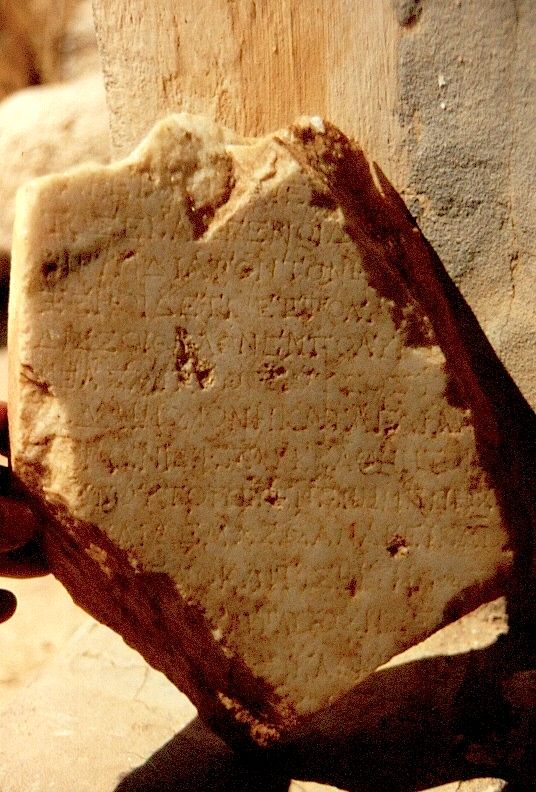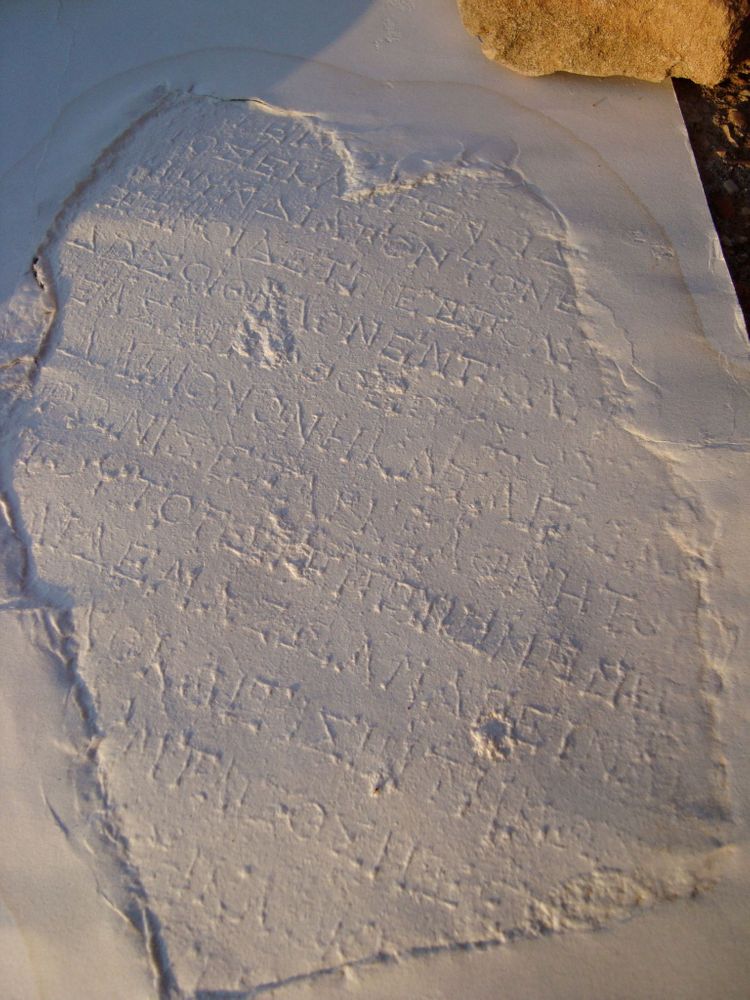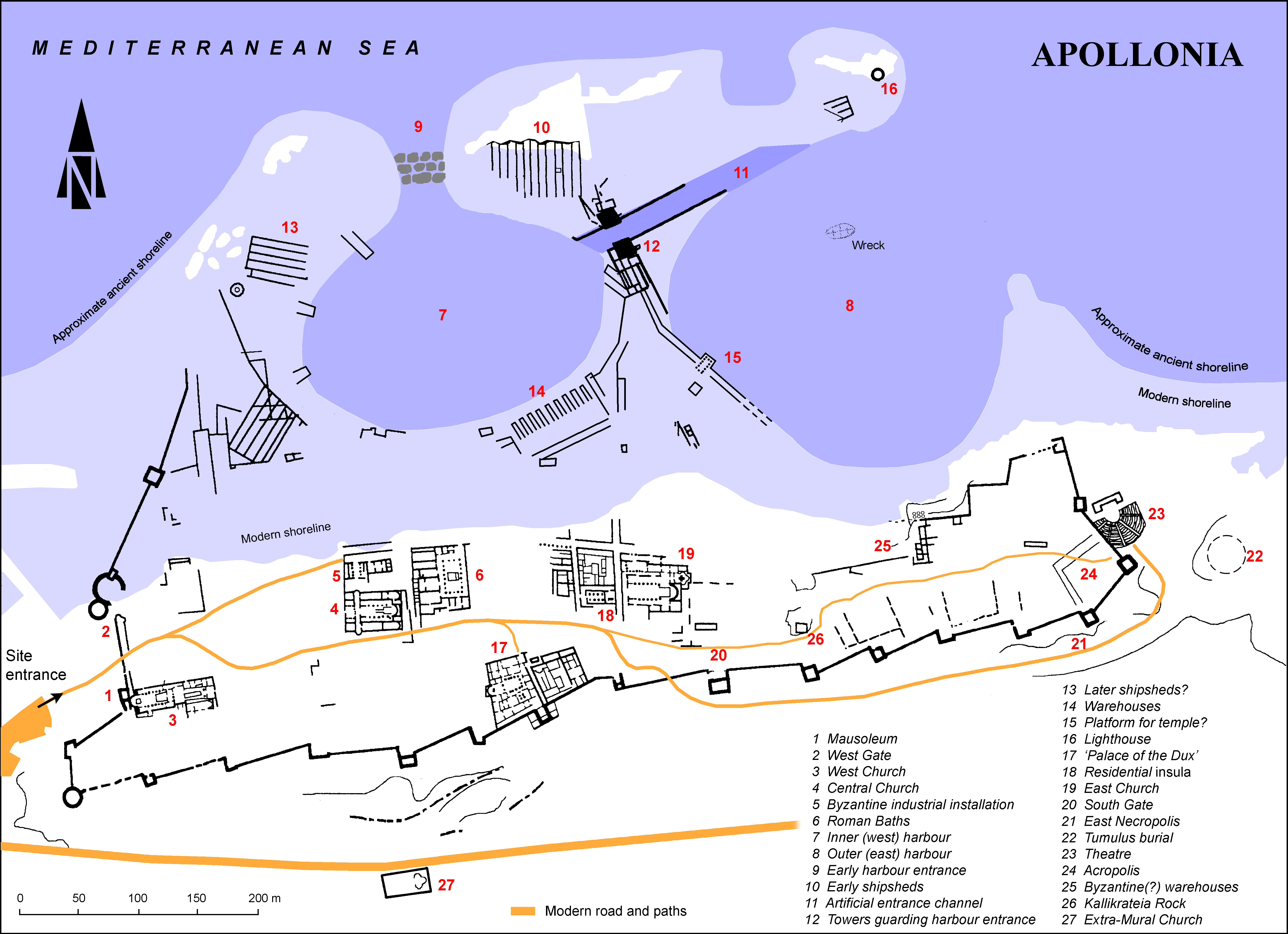EpiDoc XML:
GVCyr0522
Trismegistos ID:
738941
Source description
Support: Two non-adjacent fragments of a white marble panel:
fragm. a, broken off at top, at right and below (w: 0.21 × h: 0.24 × d: 0.05); fragm. b, broken off at top, at left and below
(w: 0.045 × h: 0.16 × d: 0.05); the back of fragm. a is regularly smoothened but for a vertical strip of 0.045 about the supposed
middle of the panel,
which is protruding, as if intended for attachment.
Layout: Inscribed on the face (fragm. a w: 0.165 × h: 0.20).
Letters: 0.008; carefully cut with small serifs; broken-bar alpha, beta with loops that are not perfectly circular and look like a
variation from kappa, oval omicron, pi with shorter right hasta, rho with very small loop, widely open upsilon, theta and
omega smaller than omicron.
Date: Probably second half of third century BC (lettering).
Findspot: Found by the French mission at the
Port of Cyrene, later Apollonia ➚:
fragment a in 1998 as a surface find and fragment b in 2003 in excavations,
below the so-called Kallikrateia Rock.
Place of origin: Probably findspot of fragment b.
Last recorded location: Apollonia Museum, Storeroom of the French Mission, not registered.
Observed by C. Dobias-Lalou in 2004 and again in 2011 at Sūsah:
Apollonia Museum, Storeroom of the French Mission.
Text constituted from: Transcription from stone (CDL).
Bibliography
Dobias-Lalou 2012, whence SEG, 62.1789; GVCyr 052 ➚.
Text
Interpretive
a
[------]
[---]βαρεια[..]ΑΙΕ[---]
[---]τος ἔκλαγεν· οἱ δ[ὲ ---]
[---]Λίβυν διὰ πόντον Ε [---]
[---]ξένοι δέ τινες πολυ[---]
5[---] δίς σοι θ[έ]λον ἐμ πολυΐ[χθυϊ πόντωι]
κ̣έλσαι π[ο]θ θεοὺς ὅσ[σοι? ---]
[---] ὦ δαῖμον, ὃν ἢ κατὰ γαῖαν̣ [ἢ κατὰ πόντον ἔτικτε]
[Κ]ορωνὶς ἐπαρκέα θνητοῖς̣
[---] τοῦτο γ' ἐ«φ'» «ἵ»π⟦νε⟧«πο»ν ἐμὴ[ν---]
10[---]χ̣αι δέμας, ὦ ἄνα, κεῖναι [---]
[---]ταο καὶ τίσιν τήκων̣ [---]
[--- σ]ύμπλοος ἥξε[ις ---]
[--- ἀνέθ]ηκαν κι[νδυν?---]
[---]ΥΠ[---]
[------] b
[---]Α
[---]ΚΙ
[---]πι (vac. 1)
[---]ΙΡΕ
5[---]Ε
[---]ΩΝΑ
[---Ἑλλά?]δος
(vac.)
a.10 χ vel θ | a.9 ancient correction from ι | ancient correction from π | πο ancient correction
Metrical
a
| [------] | [---]βαρεια[..]ΑΙΕ[---]
| [---]τος ἔκλαγεν· οἱ δ[ὲ ---]
| [---]Λίβυν διὰ πόντον Ε [---]
| [---]ξένοι δέ τινες πολυ[---]
5 | (5) [ ˉ ˘ ˘ | ˉ ] δίς σοι θ[έ]λον ἐμ πολυΐ[χθυϊ πόντωι]
| κ̣έλσαι π[ο]θ θεοὺς ὅσ[σοι? ˉ ˘ ˘ | ˉ ˘ ˘ | ˉ ± ]
| [ ˉ ˘ ˘ | ˉ ˘ ˘ | ˉ ] ὦ δαῖμον, ὃν ἢ κατὰ γαῖαν̣
[ἢ κατὰ πόντον ἔτικτε] | [Κ]ορωνὶς ἐπαρκέα θνητοῖς̣
| [---] τοῦτο γ' ἐ«φ'» «ἵ»π⟦νε⟧«πο»ν ἐμὴ[ν---]
10 | (10) [---]χ̣αι δέμας, ὦ ἄνα, κεῖναι [---]
| [---]ταο καὶ τίσιν τήκων̣ [---]
| [--- σ]ύμπλοος ἥξε[ις ---]
| [--- ἀνέθ]ηκαν κι[νδυν?---]
| [---]ΥΠ[---]
| [------]
b
[---]Α
[---]ΚΙ
[---]πι (vac. 1)
[---]ΙΡΕ
5[---]Ε
[---]ΩΝΑ
[---Ἑλλά?]δος
(vac.)
a.10 χ vel θ | a.9 ancient correction from ι | ancient correction from π | πο ancient correction
Diplomatic
a
[------]
[---]ΒΑΡΕΙΑ[++]ΑΙΕ[---]
[---]ΤΟΣΕΚΛΑΓΕΝΟΙΔ[.---]
[---]ΛΙΒΥΝΔΙΑΠΟΝΤΟΝΕ[---]
[---]ΞΕΝΟΙΔΕΤΙΝΕΣΠΟΛΥ[---]
5[---]ΔΙΣΣΟΙΘ[.]ΛΟΝΕΜΠΟΛΥΙ[..........]
.ΕΛΣΑΙΠ[.]ΘΘΕΟΥΣΟΣ[...---]
[---]ΩΔΑΙΜΟΝΟΝΗΚΑΤΑΓΑΙΑ.[.................]
[.]ΟΡΩΝΙΣΕΠΑΡΚΕΑΘΝΗΤΟΙ.
[---]ΤΟΥΤΟΓΕ«Φ»«Ι»Π⟦ΝΕ⟧«ΠΟ»ΝΕΜΗ[.---]
10[---].ΑΙΔΕΜΑΣΩΑΝΑΚΕΙΝΑΙ[---]
[---]ΤΑΟΚΑΙΤΙΣΙΝΤΗΚΩ.[---]
[---.]ΥΜΠΛΟΟΣΗΞΕ[..---]
[---....]ΗΚΑΝΚΙ[....---]
[---]ΥΠ[---]
[------]b
[---]Α
[---]ΚΙ
[---]ΠΙ
[---]ΙΡΕ
5[---]Ε
[---]ΩΝΑ
[---....]ΔΟΣ
vacat
a.10 χ vel θ | a.9 ancient correction from ι | ancient correction from π | πο ancient correction
French translation
a) [---] pesante [---] a grondé; et les [---] à travers la mer de Libye [---]; et des étrangers aux nombreux [---] deux fois ils ont voulu te [---] dans la [mer] peuplée de [poissons ---] aborder chez les dieux qui [---]; dieu, que Korônis enfanta secourable aux mortels sur terre et sur mer, [---], quant à cela, sur ma cavale, [---]; elles (scil. sont) [---] de stature, seigneur, celles-là; [---] et dissolvant le châtiment [---] tu viendras en auxiliaire de notre traversée [--- ont dé]dié [---] aux dangers [---].
b) [---] de la Grèce [---].
English translation
[---] heavy [---] roared; and the [---] through the Libyan sea [---]; and foreigners with many [---] twice they wanted to you [---] in the [sea] with many [fishes ---] to land at the gods' place who [---]; oh god, whom Koronis brought forth helpful for the mortals on land and sea, [---], as to this, upon my mare, [---]; they (scil. are) [---] in stature, lord, those; [---] and dissolving the retribution [---] you will come as auxiliary of our sailing [--- dedi]cated [---] the dangers [---].
b) [---] of Greece [---].
Italian translation
a)[---] pesante [---] mugghiò; e i [---] attraverso il mare della Libia [---]; e stranieri con molti [---] due volte vollero per te [---] nel [mare] dai molti [pesci ---] per approdare presso gli dèi che [---]; dio, soccorso per i mortali sulla terra e per mare, che Koronis generò, [---], quanto a questo, sulla mia cavalla, [---]; (scil. sono) [---] per statura, o signore, quelle; [---] e sciogliendo la pena [---] tu verrai in aiuto alla nostra navigazione [--- hanno dedi]cato [---] i pericoli [---].
b) [---] dell'Ellade [---].


